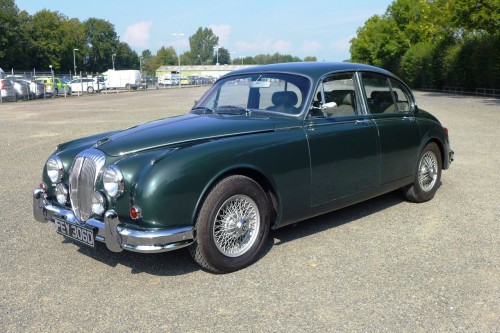
Click Here for Full Screen Image - Click Here to Download Image
 |  |  |  |  | |||||
 |  |  |  |  | |||||
 |  |  |  |  | |||||
 |  |  |  |
| Lot number | 46 |
|---|---|
| Hammer value | £8,000 |
| Description | Daimler 2.5 V8 |
| Registration | FEY 306D |
| Year | 1966 |
| Colour | Opalescent Green |
| Engine size | 2,548 cc |
| Chassis No. | P1A9150BW |
| Engine No. | YA9690 |
| Documents | V5C; MOT September 2016; 18 old MOTs; buff logbook; large history file; photographs and other invoices |
Apart from gaining a much-needed extra factory, Jaguar's acquisition of Daimler in 1960 also brought with it the exquisite Ed Turner-designed V8 engine used in the Dart sportscar.
By installing this 2,548cc 'hemi' into the MKII bodyshell, Jaguar hoped to create a more exclusive, upmarket car that would appeal to Daimler's more traditional client base.
Launched in 1962, the new model was instantly distinguished from its Jaguar siblings by the traditional Daimler fluted grille and was initially only available with a bench front seat and 3-speed automatic box. It was updated in 1967 with reclining front seats, slimmer bumpers, dynamo rather than alternator charging, a heated rear screen and various other upgrades, this model being known as the 250 V8 rather than the 2.5 V8.
Otherwise identical to the MKII, it featured all round disc brakes, independent front suspension and a Panhard rod located live rear axle. With 140bhp and 155lbft of torque on tap from its magnificently smooth and sonorous V8, the Daimler was capable of 115mph. It was also said to enjoy superior chassis dynamics to its Jaguar siblings thanks to its more favourable weight distribution due to the relatively light-weight engine.
This late 1965 manufactured 2.5 V8 model was first registered in January 1966. The original green logbook shows that it was registered T 555 at some point, although this has since been replaced with its current age-related plate.
The car has a large history file covering the mid-1990s onwards, photographs showing a thorough bare metal respray and comprehensive restoration, the majority of which took place during 1999. Eighteen old MOTs starting from around that time show its subsequent usage and a stack of invoices from specialist suppliers show its continued maintenance and improvement (there are probably around 40 invoices spread between Norman Motors and David Manners alone). There is also an original handbook, workshop manual and lubrication chart included in the paperwork.
Recent work has included a brake and major suspension overhaul, including polybushes to the rear springs and spring pads, as well as an overhaul of the front suspension. Further bills refer to the repair of the radio, electric clock and further rechroming work which has also taken place within the last 5 years.
The cabin has been subtly but luxuriously upgraded with a later XJ40 Vanden Plas interior carefully installed. So well has this been executed that only those familiar with the model would detect that it was not original, the superb electrically adjustable front seats and individual rear seats cleverly re-worked to fit into the smaller Daimler bodyshell, along with more modern inertia reel seatbelts. Other upgrades include electronic ignition and power steering which makes it much nicer to drive. Attractive wire wheels and a Motolita steering wheel add a welcome sporting touch.
Already MOTd until April 2016, the vendor intends to obtain a new 12 month ticket in time for the sale. This attractive older restoration is regularly exercised and offers an extremely comfortable and civilised mode of classic transport.